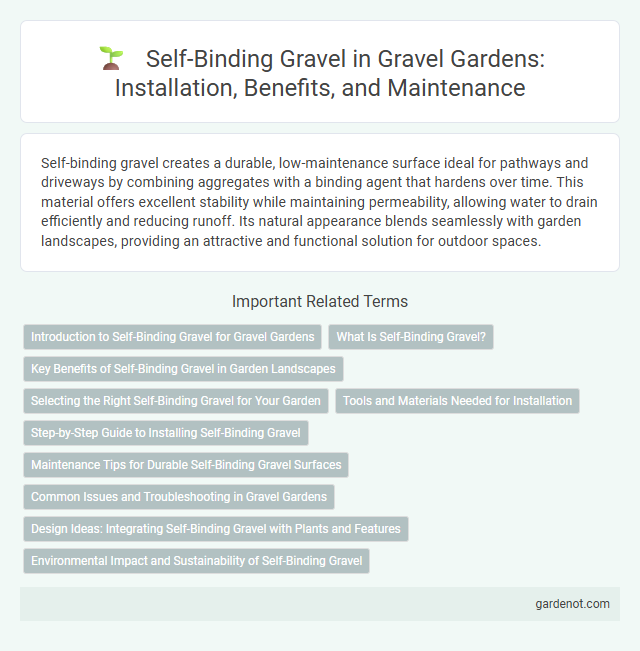Self-binding gravel creates a durable, low-maintenance surface ideal for pathways and driveways by combining aggregates with a binding agent that hardens over time. This material offers excellent stability while maintaining permeability, allowing water to drain efficiently and reducing runoff. Its natural appearance blends seamlessly with garden landscapes, providing an attractive and functional solution for outdoor spaces.
Introduction to Self-Binding Gravel for Gravel Gardens
Self-binding gravel is an innovative material ideal for gravel gardens, offering durability and a stable surface without the need for binding agents or extensive groundwork. Its natural ability to compact and interlock creates a firm, yet permeable layer that supports foot traffic and prevents displacement. Ideal for pathways and garden beds, self-binding gravel combines practicality with aesthetic appeal in sustainable garden design.
What Is Self-Binding Gravel?
Self-binding gravel is a type of aggregate composed of crushed stone particles coated in a natural binding agent, allowing it to compact firmly without loose stones. This material provides a stable, permeable surface ideal for pathways, driveways, and garden areas, reducing dust and erosion. Its durable composition offers low maintenance while enhancing the aesthetic appeal of gravel gardens.
Key Benefits of Self-Binding Gravel in Garden Landscapes
Self-binding gravel offers excellent stability by naturally compacting into a solid surface, reducing soil erosion and minimizing maintenance in garden landscapes. Its porous nature enhances drainage, preventing water pooling and promoting healthier plant roots. This versatile material also provides an attractive, natural aesthetic that complements various garden designs while supporting foot traffic and pathways.
Selecting the Right Self-Binding Gravel for Your Garden
Selecting the right self-binding gravel for your garden involves considering factors such as particle size, color, and durability to ensure stability and aesthetic appeal. Opt for gravel with a mixture of fine and coarse particles, typically 6-10 mm in size, which locks together to create a firm, natural-looking surface ideal for pathways and patios. High-quality self-binding gravel made from limestone or granite provides excellent compaction, reducing maintenance while enhancing drainage and preventing weed growth.
Tools and Materials Needed for Installation
Self-binding gravel installation requires essential tools and materials including a compactor for firm surface consolidation, a sturdy rake to evenly spread gravel, and landscape fabric to prevent weed growth and enhance stability. High-quality self-binding gravel with a mix of fine and coarse particles ensures effective locking and durability. Proper drainage solutions like edge restraints or perforated pipes also help maintain the gravel's integrity over time.
Step-by-Step Guide to Installing Self-Binding Gravel
Begin by preparing the site with proper excavation to a depth of at least 4 inches, ensuring the area is level and free of debris. Next, lay a geotextile membrane to prevent weed growth and improve stability, then spread a 2-3 inch layer of coarse base gravel before compacting it thoroughly. Finally, apply a 2-3 inch layer of self-binding gravel, rake it evenly, and compact the surface using a roller or plate compactor to achieve a durable, firm finish.
Maintenance Tips for Durable Self-Binding Gravel Surfaces
Regularly sweeping self-binding gravel removes debris and prevents weed growth, ensuring a smooth, durable surface. Applying a gravel stabilizer or binding agent annually reinforces the gravel's cohesion, reducing displacement and erosion. Proper drainage management prevents water pooling, which can weaken the binding and cause surface degradation.
Common Issues and Troubleshooting in Gravel Gardens
Self-binding gravel in gravel gardens often faces common issues such as surface cracking, poor compaction, and weed growth through the aggregate. Troubleshooting these problems involves regularly topping up the gravel layer to maintain thickness, using polymer additives to enhance binding strength, and applying appropriate weed barriers underneath the gravel. Proper drainage and periodic maintenance can prevent water retention problems that cause gravel displacement and deterioration.
Design Ideas: Integrating Self-Binding Gravel with Plants and Features
Self-binding gravel offers a stable, permeable surface ideal for creating pathways and patios that blend seamlessly with lush plantings and garden features. Combining this material with native grasses, succulents, and mosses enhances texture while promoting drainage and reducing erosion. Incorporating features such as natural stone edging or wooden benches further complements the organic aesthetic, creating a harmonious outdoor space that balances durability with natural beauty.
Environmental Impact and Sustainability of Self-Binding Gravel
Self-binding gravel reduces environmental impact by minimizing the need for chemical binders or concrete, allowing rainwater to permeate naturally and support groundwater recharge. Its sustainable properties include using locally sourced aggregates and promoting biodiversity by preventing soil erosion and supporting plant growth in gravel garden designs. This eco-friendly alternative enhances garden durability while aligning with green landscaping practices aimed at reducing carbon footprints.
Self-binding gravel Infographic

 gardenot.com
gardenot.com